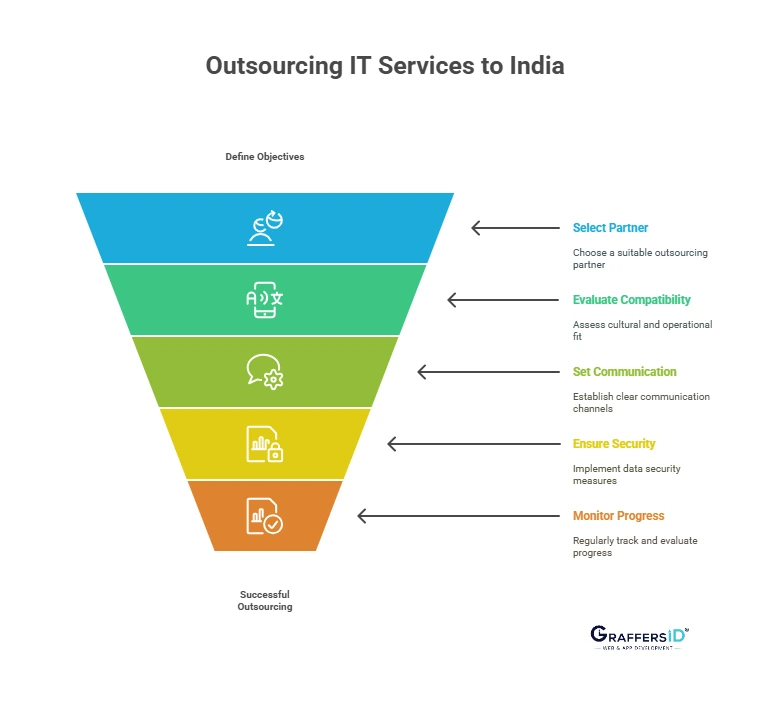In today’s globalized business landscape, outsourcing has become a critical strategy for companies aiming to reduce costs and improve efficiency. Two prominent outsourcing destinations, India and the United States, stand out for their unique advantages and drawbacks. However, the question is, “Is outsourcing to India still more cost-effective and feasible than hiring in the USA?”
In this article, we will compare the actual costs, value, quality, and risks of outsourcing software development to India vs. the United States. With the support of market statistics, expert analysis, and insightful comparisons, this blog can help you make a data-driven choice in 2026.
What is Outsourcing?
Outsourcing in software development refers to hiring external developers or teams to build, maintain, or scale software products instead of maintaining a full-time, in-house development team.
Reports show that by the end of 2026, the size of the global outsourcing market is expected to reach $971 billion. With 45% of the global IT outsourcing market, India continues to be the leading market for software development and IT outsourcing.
Benefits of Outsourcing
In 2026, outsourcing software development is a strategic growth tool instead of just a way to reduce expenses. Here are the main advantages:

- Access to Global Talent: Access a large pool of skilled developers, designers, and testers with expertise in modern technologies, advanced programming languages, and emerging tech stacks.
-
Cost Efficiency: Significantly reduced labor and operating costs, especially when outsourcing to countries like India, the Philippines, or Eastern Europe with competitive pay structures and exchange rates.
-
Focus on Core Functions: By outsourcing non-core tasks, companies can better focus on innovation and growth.
- Scalability and Flexibility: Teams can be easily scaled up or down depending on project requirements without worrying about long-term employment agreements or office space.
-
Faster Time-to-Market: Outsourcing partners often have teams that are ready to get started immediately, which reduces development cycle times and speeds up product launches.
-
24/7 Productivity: Offshore teams in different time zones can ensure ongoing project progress, allowing for quicker delivery and less downtime.
Read More: Advantages and Disadvantages of Outsourcing
Outsourcing in India vs. USA: Key Differences
Let’s delve into a detailed comparison of outsourcing to India and the USA based on various key factors:

1. Labor Costs
One of the primary reasons companies opt for outsourcing is the potential for significant cost savings. Labor costs are often a substantial part of a business’s expenses, and this is where India has traditionally held a competitive advantage. Indian outsourcing providers can offer services at a fraction of the cost of their American counterparts, making it an attractive proposition for businesses looking to cut operational expenses.
- India:
The Indian outsourcing market has flourished due to its vast pool of highly skilled, English-speaking professionals willing to work for comparatively lower wages. This cost advantage extends across various sectors, including IT services, customer support, and business process outsourcing (BPO). Moreover, India’s favorable exchange rates can amplify cost savings for foreign clients.
- USA:
Labor costs in the United States are considerably higher than in India. However, it’s essential to note that the U.S. still offers a significant advantage in certain areas, particularly when it comes to highly specialized, knowledge-intensive tasks that require creativity and innovation. For industries where the quality of work and intellectual property protection are paramount, the U.S. remains a preferred choice.
Complete Cost Comparison Table: India vs USA
| Cost Factor | India (Approx) | USA (Approx) | Notes |
| Hourly Developer Rate | $10 – $55 | $50 – $200 | Based on role & experience |
| Monthly Cost per Developer | $1,600 – $8,800 | $8,000 – $32,000 | 160 hours/month avg. |
| Recruitment Cost | $200 – $500 | $3,000 – $7,000 | Agency or internal team cost |
| Infrastructure & Setup | $500 – $1,000 | $5,000 – $10,000 | Includes hardware/software/licenses |
| Legal & Compliance | $300 – $600 | $2,000 – $5,000 | NDA, IP protection, contracts |
| Attrition Handling | Low (10–15%) | High (20–30%) | Higher in US due to demand |
| Tax & Benefits | Minimal (5–10%) | High (30–40%) | Payroll taxes, insurance, benefits |
| Overall Project Cost | 30–70% less than USA | — | Varies by scope and vendor |
2. Quality and Skill Set
While cost savings are crucial, they should not come at the expense of quality and expertise. A cost-benefit analysis should factor in the skills and capabilities of the workforce in both countries.
- India:
India’s education system produces a large number of engineering and technical graduates each year, resulting in a vast talent pool of IT professionals. However, there can be variances in the quality of work among service providers. Some companies may excel in certain areas, while others may require more oversight to meet international standards.
- USA:
The United States boasts a highly skilled workforce, often considered the gold standard in industries like software development, design, and research. American professionals are renowned for their innovative thinking and problem-solving abilities. However, these talents come at a premium cost.
3. Time Zone and Communication
Effective communication and collaboration are vital for successful outsourcing partnerships. Time zone differences can either be an advantage or a hindrance, depending on the nature of the work.
- India:
India’s time zone difference, which is typically 9-12 hours ahead of the Eastern Time Zone in the U.S., can be leveraged to achieve round-the-clock productivity. This allows for tasks to be worked on continuously, offering potential time savings. However, it can also pose challenges in terms of real-time communication and decision-making.
- USA:
When outsourcing to U.S. providers, the time zone alignment may be more favorable for real-time communication. This can lead to faster response times and quicker issue resolution, which is essential for time-sensitive projects. However, it may not be as beneficial for businesses looking to maximize operational hours.
4. Intellectual Property Protection and Data Security
Protecting intellectual property and sensitive data is a paramount concern for businesses in the outsourcing process.
- India:
India has made significant strides in enhancing its legal framework to protect intellectual property and data security. Reputable outsourcing companies in India adhere to international data security standards, such as ISO 27001. However, there have been occasional data breaches and intellectual property concerns in the past, so careful selection of outsourcing partners is crucial.
- USA:
The United States offers robust legal protection for intellectual property and data security. When outsourcing to U.S. companies, clients often have more straightforward recourse in case of data breaches or IP theft. This can be a significant advantage for businesses dealing with sensitive information.
Read More: Nearshore vs Offshore Outsourcing: What to Choose in 2026?
India vs USA: Outsourcing Partner Comparison Table (2026)
| Factor | India | USA |
| Cost Efficiency | Extremely high (up to 70% savings) | Low – significantly higher salaries and overhead |
| Talent Pool Size | Massive and growing; 5M+ developers | Limited compared to India; smaller hiring pool |
| Tech Expertise | Strong in MERN, AI/ML, Python, Java, DevOps | Strong in enterprise systems, cloud, product innovation |
| Time Zone Advantage | Favors 24/7 development for Western clients | Same timezone – better for real-time collaboration |
| Cultural Compatibility | Moderate; good with Western business practices | High; naturally aligned with local culture |
| Data Security | Improved; governed by IT Act + NDAs, but still a concern | Very high; strong legal protection and data compliance (GDPR, HIPAA, etc.) |
| Communication & Collaboration | Reliable; most teams adapt to client timezone/tools | Seamless; no language barrier or timezone delay |
How to Outsource IT Services to India in 2026?
Below are the steps on how to successfully outsource your IT needs to India in 2026:

1. Define Your Objectives and Requirements
Before you begin your outsourcing journey, clearly define your project objectives and requirements. Determine the specific IT services you need, whether it’s software development, website maintenance, or IT support.
2. Select a Desired Outsourcing Partner
Conduct thorough research to identify potential outsourcing partners in India. Look for outsourcing companies with a proven track record, expertise in your industry, and a portfolio that aligns with your project requirements. Consider factors like company size, experience, and client reviews.
3. Evaluate Cultural Compatibility
While language isn’t a barrier, understanding and respecting cultural differences are essential for effective collaboration. Ensure that your outsourcing partner has a culture that aligns with your company’s values and work ethic.
4. Set Clear Communication Channels
Establish effective communication channels to bridge the geographical gap. Regular video conferences, instant messaging platforms, and project management tools can facilitate smooth interactions.
5. Ensure Data Security and Confidentiality
Data security is paramount. Make sure your outsourcing partner follows strict data protection protocols and complies with international data security standards like GDPR, if applicable.
6. Monitor Progress Regularly
Set milestones and timelines, monitor progress, discuss challenges, and address any issues promptly to ensure the project stays on track. Establish a feedback loop with your outsourcing partner to encourage continuous improvement.
Read More: Staff Augmentation vs. Outsourcing: Choosing the Right Model for Your Business
Conclusion
The choice between outsourcing to the USA or India in 2026 depends on your specific business goals and requirements.
If reducing costs is your primary objective and you require access to services that are well-established in the outsourcing market, India may be the preferred option. It’s perfect for companies that want to grow fast and have access to a large number of skilled employees.
For companies that need professional expertise, innovation, or strong data protection regulations, the USA might be a better choice. Although they are more expensive, US outsourcing companies deliver premium services.
The best of them both may ultimately be achieved through a hybrid outsourcing model that combines the advantages of both countries.
Selecting the right outsourcing partner, doing in-depth research, and clear communication are all necessary to make an informed choice that will fulfill your business goals and ensure long-term success.
Want to scale your tech team without going over budget?
Hire remote developers from India with GraffersID and reduce development costs by up to 60%.





